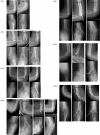Low incidence of flexion-type supracondylar humerus fractures but high rate of complications
- PMID: 27168001
- PMCID: PMC4967285
- DOI: 10.1080/17453674.2016.1176825
Low incidence of flexion-type supracondylar humerus fractures but high rate of complications
Abstract
Background and purpose - Supracondylar humerus fractures are the most common type of elbow fracture in children. A small proportion of them are flexion-type fractures. We analyzed their current incidence, injury history, clinical and radiographic findings, treatment, and outcomes. Patients and methods - We performed a population-based study, including all children <16 years of age. Radiographs were re-analyzed to include only flexion-type supracondylar fractures. Medical records were reviewed and outcomes were evaluated at a mean of 9 years after the injury. In addition, we performed a systematic literature review of all papers published on the topic since 1990 and compared the results with the findings of the current study. Results - During the study period, the rate of flexion-type fractures was 1.2% (7 out of 606 supracondylar humeral fractures). The mean annual incidence was 0.8 per 105. 4 fractures were multidirectionally unstable, according to the Gartland-Wilkins classification. All but 1 were operatively treated. Reduced range of motion, changed carrying angle, and ulnar nerve irritation were the most frequent short-term complications. Finally, in the long-term follow-up, mean carrying angle was 50% more in injured elbows (21°) than in uninjured elbows (14°). 4 patients of the 7 achieved a satisfactory long-term outcome according to Flynn's criteria. Interpretation - Supracondylar humeral flexion-type fractures are rare. They are usually severe injuries, often resulting in short-term and long-term complications regardless of the original surgical fixation used.
Figures


References
-
- Alburger P D, Weidner P L, Betz R R.. Supracondylar fractures of the humerus in children. J Pediatr Orthop 1992; 12 (1): 16–19. - PubMed
-
- Cheng J C, Lam T P, Maffulli N.. Epidemiological features of supracondylar fractures of the humerus in chinese children. J Pediatr Orthop B 2001; 10 (1): 63–7. - PubMed
-
- Cusick M C, Bonnaig N S, Azar F M, Mauck B M, Smith R A, Throckmorton T W.. Accuracy and reliability of the mayo elbow performance score. J Hand Surg 2014; 39 (6): 1146–50. - PubMed
-
- De Boeck H. Flexion-type supracondylar elbow fractures in children. J Pediatr Orthop 2001; 21 (4): 460–3. - PubMed
-
- de Boer Y A, Hazes J M, Winia P C, Brand R, Rozing P M.. Comparative responsiveness of four elbow scoring instruments in patients with rheumatoid arthritis. J Rheumatol 2001; 28 (12): 2616–23. - PubMed
MeSH terms
LinkOut - more resources
Full Text Sources
Other Literature Sources
Medical
